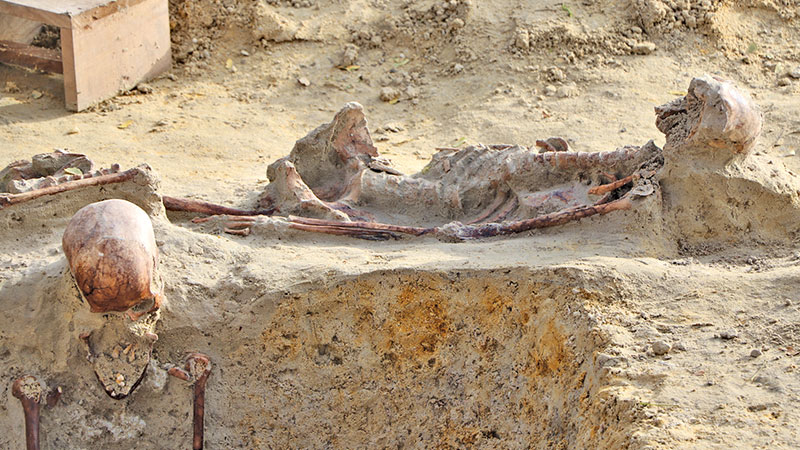By Shabeer Mohamed.
The second phase of excavation work at the Chemmani mass grave in Jaffna was completed yesterday. The site at the Sindhubathi Hindu cremation grounds, has become the second-largest mass grave in Sri Lanka. Nineteen skeletons were identified in the investigations that began with the first phase, which concluded on June 7.
The second phase commenced on June 26 and was carried out in three stages, with two breaks, over 45 days. Throughout this period, soil tests, public exhibitions, scanning and forensic activities were also conducted under the supervision of the Jaffna Magistrate to ensure judicial oversight and transparency. The Ministry of Justice provided nearly two million rupees in funding for this phase, underlining the State’s formal role in the excavation effort.
Discuss the findings
 On August 4, three Commissioners from the Human Rights Commission of Sri Lanka, Prof. Thaiyamuthu Thanaraj, Prof. Fathima Farzana Haniffa, and Dr. Gehan Dinuk Gunatilleke, visited the site. They were joined by Jaffna Regional Coordinator Thangavel Kanagaraj and other officials, who met forensic experts to review and discuss the findings after 30 days of excavation.
On August 4, three Commissioners from the Human Rights Commission of Sri Lanka, Prof. Thaiyamuthu Thanaraj, Prof. Fathima Farzana Haniffa, and Dr. Gehan Dinuk Gunatilleke, visited the site. They were joined by Jaffna Regional Coordinator Thangavel Kanagaraj and other officials, who met forensic experts to review and discuss the findings after 30 days of excavation.
The following days had further developments. On August 4 and 5, Ground Penetrating Radar (GPR) scanning was conducted by the Faculty of Technology at the University of Sri Jayewardenepura, using specialised equipment to detect potential hidden burial sites.
Meanwhile, on August 5, following a court order, clothing and personal belongings recovered from the grave were displayed publicly. The exhibition was attended by more than 200 people, including families of the missing officials from the Office on Missing Persons (OMP), and members of the public. It was supported by students of the University of Jaffna’s Medical Faculty and Judicial Medical Officers. Despite the anticipation, no items were positively identified during this display.
Formal conclusion
 The Chemmani Mass Grave case was taken up again in the Jaffna Magistrate’s Court on September 6, before Jaffna District Additional Magistrate S. Leninkumar. This hearing marked the formal conclusion of the second phase of excavations, which lasted 45 days. Combined with the initial nine-day phase earlier this year, the investigations at the site have now spanned for 54 days.
The Chemmani Mass Grave case was taken up again in the Jaffna Magistrate’s Court on September 6, before Jaffna District Additional Magistrate S. Leninkumar. This hearing marked the formal conclusion of the second phase of excavations, which lasted 45 days. Combined with the initial nine-day phase earlier this year, the investigations at the site have now spanned for 54 days.
According to the findings presented, 240 sets of skeletons were identified, of which 239 were fully excavated. All of the remains have been handed over to Forensic Medical Officer Selliah Pranavan for further examination. Alongside the skeletal discoveries, approximately 70 artefacts were also recovered and have been placed in the custody of the Court at Jaffna.
The excavations have significantly expanded the scope of the burial grounds. What began as an 11-metre length and width has now grown into a vast pit measuring 24.4 metres in length and 11.2 metres in width. Excavation work was conducted across two sites: the first revealed 230 human remains, while the second produced nine. In addition, fourteen piles of mixed human remains were unearthed during the process.
Based on earlier scanning results, Prof. Raj Somadeva told the court that a third phase of excavation should be undertaken, and expected to last another eight weeks. However, this will require additional funding to proceed. As a result, the case has been adjourned until September 18, when experts are scheduled to submit their report to the Court, and the question of financing for the next phase will be addressed.
Executive Director of the Office for the Missing Persons (OMP), Dr. J. Thatparan said that under the powers vested in the OMP, its officials met Somarathna Rajapaksa, a former Military officer involved in the first Chemmani case. He said that the OMP will submit a report and recommendations regarding this meeting to the Court and the relevant institutions.
Formal applications
Attorney V.K. Niranjan also addressed legal questions surrounding the case, particularly the possibility of merging the current proceedings with the first Chemmani mass grave case from 1999. He said that the Magistrate’s Court does not have jurisdiction to merge the two, saying that such authority rests with the Court of Appeal and can only be exercised through formal applications.
The Chemmani mass grave remains a stark reminder of the many unresolved cases of enforced disappearances from Sri Lanka’s war years. Each phase of excavation has uncovered not only human remains but also painful truths about a past that continues to demand accountability. For families still waiting for answers, the work ahead is as much about justice as it is about remembrance, and the decisions in the coming weeks will determine whether this process moves closer to uncovering the full truth.
Pictures: Shabeer Mohamed
